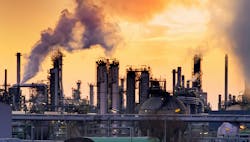- Power plants were the largest stationary source of U.S. greenhouse gas emissions, with 1,320 facilities emitting approximately 1.5 billion metric tons of carbon dioxide. Reported power plant emissions decreased by 7.2%. There is a 33.8% decrease in emissions since 2011 reflecting the long-term shifts in power sector fuel-stock from coal to natural gas.
- Petroleum and natural gas systems were the second largest stationary source of reported emissions, reporting 322 million metric tons of greenhouse gas emissions. Reported emissions for 2023 were 1.4% higher than in 2022, and 16.4% higher than 2016. (2016 is the earliest year of comparable data for this sector, as new industry segments began reporting that year.)
- Reported direct emissions from other large sources in the industrial and waste sectors were a combined 785 million metric tons of greenhouse gas emissions in 2023, down 1.1% from 2022, and down 10.3% since 2011.
- From 2011 to 2023, total reported GHG emissions from large facilities decreased by approximately 22%, driven by a decrease in power plant emissions.
About the Author
Amanda Joshi
Managing Editor
Amanda Joshi has more than 18 years of experience in business-to-business publishing for both print and digital content. Before joining Chemical Processing, she worked with Manufacturing.net and Electrical Contracting Products. She’s a versatile, award-winning editor with experience in writing and editing technical content, executing marketing strategy, developing new products, attending industry events and developing customer relationships.
Amanda graduated from Northern Illinois University in 2001 with a B.A. in English and has been an English teacher. She lives in the Chicago suburbs with her husband and daughter, and their mini Aussiedoodle, Riley. In her rare spare time, she enjoys reading, tackling DIY projects, and horseback riding.

